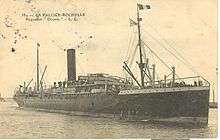Pacific Steam Navigation Company
The Pacific Steam Navigation Company (Spanish: Compañía de Vapores del Pacífico) was a commercial shipping company that operated along the Pacific coast of South America, and was the first to use steam ships for commercial traffic in the Pacific Ocean.[1]
.jpg)
History
The company was founded by William Wheelwright in London in 1838 and began operations in 1840 when two steam ships Chile and Peru were commissioned to carry mail.[2] Early ports of call were Valparaíso, Coquimbo, Huasco, Copiapó, Cobija, Iquique, Arica, Islay, Pisco and Callao. In 1846 the company expanded its routes to include Huanchaco, Lambayeque, Paita, Guayaquil, Buenaventura and Panama City.
In 1852 the company gained a contract for British Government mail to posts in western South America. Two direct routes were also established - Liverpool to Callao in 1868 and London to Sydney in 1877.[2] In common with its contemporaries, the company lost a number of ships in its early decades. They included Tacna, which exploded in 1874 killing 19 people, and Atacama, which ran aground in 1877 killing 102 people.[3]

In 1905 the company sold its London – Sydney route to the Royal Mail Steam Packet Company, which bought the entire company in 1910.[2] Pacific Steam continued to lose ships at sea. In 1902 Arequipa was wrecked in a gale, killing 63 people. In 1907 Santiago met a similar fate, killing 45 people. In 1911 Taboga ran aground, killing 60 people.[3]
In the First World War ten of the company's ships were sunk, but at the relatively light cost of only 15 lives.[3] In the Second World War a German submarine torpedoed a Pacific Steam passenger liner, Oropesa, sinking her and killing 106 people.[4]
RMSP's name and routes were retained until Furness Withy bought Royal Mail in 1965.[5] Following the purchase the separate Pacific Steam Navigation Company structure was abolished and the vessels rebranded, effectively signalling the end of the Company.[2]
In 1919, the company began a house magazine called Sea Breezes. The journal outlived the company and it still exists, with a focus on international shipping matters.
Routes
| Years | Type | Principal Route | Ports of call |
|---|---|---|---|
| 1843–1923 | Chile - Peru | Valparaíso - coastal ports - Callao | |
| 1846–1923 | Chile - Panama | Valparaíso - Callao - Guayaquil - Panama | |
| 1848–1923 | Chile (domestic) | Valparaíso - Puerto Montt (Chile) | |
| 1868–1920 | Europe - Chile | Liverpool - Bordeaux - Lisbon - Cape Verde - Rio de Janeiro - Montevideo - Punta Arenas - Valparaíso (from 1870) - Arica - Mollendo - Callao | |
| 1877–1879 | Mail, passengers | Europe- Argentina | Liverpool - Bordeaux - Buenos Aires |
| 1904–1920 | Mail, passengers | Europe - Argentina | Liverpool - La Pallice - Corunna - Vigo - Lisbon - Recife - Salvador - Rio de Janeiro - Montevideo - Buenos Aires - Port Stanley - Punta Arenas - Coronel - Talcahuano - Valparaíso |
| 1914–1945 | Panama (domestic) | Cristóbal - Panama Canal - Champerico |
References
- SÍNTESIS HISTÓRICA DE ALGUNOS NAUFRAGIOS OCURRIDOS EN EL ESTRECHO DE MAGALLANES Y CANALES ADYACENTES DESDE SU DESCUBRIMIENTO HASTA 1900 Archived 14 April 2012 at the Wayback Machine, retrieved 6.December 2011
- "Pacific Steam Navigation Company". The Ships List. 2007. Archived from the original on 5 August 2011. Retrieved 15 February 2008.
- "Pacific Steam Navigation Co". Ship Owners. WreckSite. Retrieved 16 December 2013.
- Helgason, Guðmundur (1995–2013). "Oropesa". Ships hit by U-boats. Guðmundur Helgason. Retrieved 15 December 2013.
- "Shipping Lines: Royal Mail Steam Packet Company". Archived from the original on 21 January 2013. Retrieved 28 March 2009.